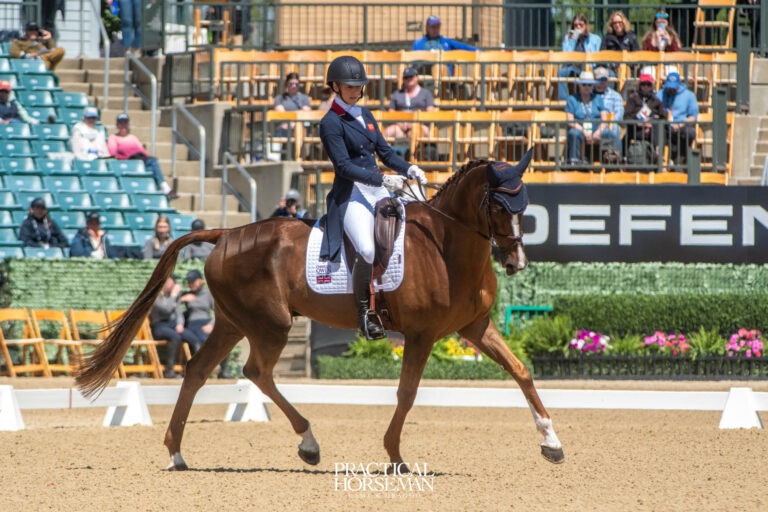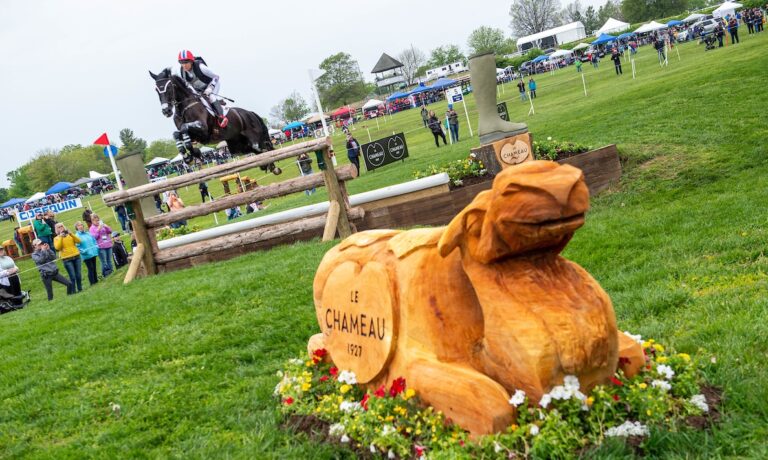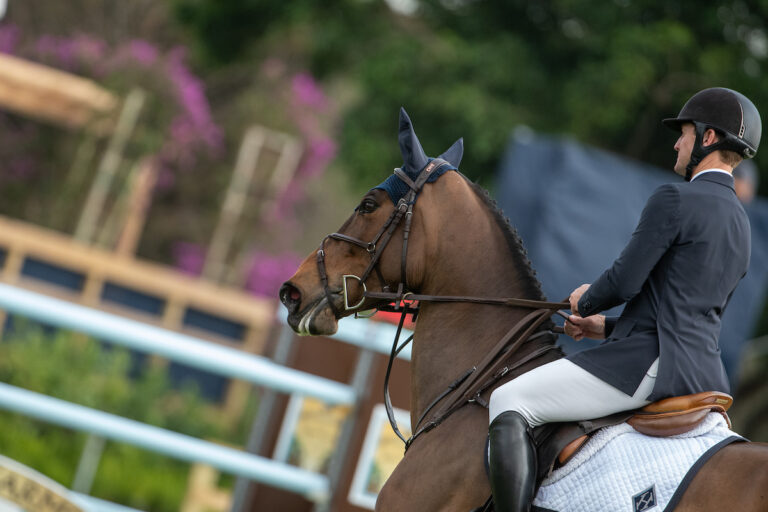Read award-winning journalist Nancy Jaffer’s latest report on the world of equestrian sport. Brought to you by Practical Horseman magazine. Visit Nancy’s archive for past columns.

March 20, 2009 — The launch this month of the North American Riders Group (NARG) by some of the U.S.’s top show jumpers is a hopeful sign for up-and-coming trainer Leah Epstein.
Although NARG has lofty goals to improve things at the upper end of the sport, in the face of rising costs and what it calls declining quality of shows, it is also looking at the big picture. Leah is encouraged by the organization’s desire to boost the lower end of the industry as well.
“We believe that in order for the sport to prosper, we must have top-quality horse shows at every level of our sport,” NARG President Chris Kappler explained during a reception last month, where nearly 300 people showed up at a Wellington, Fla., country club to learn about the new entity.
“Without quality local horse shows, we can’t hope to end up with world class jumping events,” Chris said.
When Leah, based in Saugerties, N.Y., takes a group of her riders to the Florida shows, she notes, “I have a lot of kids I leave at home in the winter who are desperate to be involved.” But costs are prohibitive.
As an alternative, local shows cannot be the answer if their standards aren’t up to snuff.
“I think some of those local (shows) would like to do a better job; they just don’t know how,” Leah said, contending that if they could get information from NARG, “they would gobble up the input.”
The current economic downturn has made costs an issue among the elite as well as the lower echelons. “If we don’t start to address the financial cost of our sport, starting at the top level down, there’s going to be no sport for those people starting out now,” said McLain Ward, NARG’s vice president.
“It’s going to be a country club. The only people who can be able to afford it are the extremely affluent. It’s not that we don’t want the affluent in the sport; of course we do, but that’s not the only people we want in the sport. We want to make the sport less exclusive.
“We also have to deal with the standards of the shows, starting at the highest level and trickling down, so the smaller shows understand what a good show is, what good footing is, what a well-organized event is,” noted McLain.
“In Germany, which runs the greatest show in the world, Aachen, if you go to a very small local horse show, they are influenced by the standards set by Aachen; they want to do better. I think that’s in any industry. Anyone who wants to do a good job wants to see what the best is and in their own small way try to emulate it,” he continued. “We hope to set a standard on every front. We hope that brings up the rest.”
The NARG board is packed with high-profile names: Beezie Madden, Kent Farrington, Norman Dello Joio and Jimmy Torano. They are encouraging other jumper riders, as well as hunter riders, trainers, owners and sponsors, to pay the $250 membership fee to join them in their effort, outlined on the Web at www.narg.org.
“Our strength is in numbers,” maintained Chris.
The group had its roots in a Kentucky meeting last fall, where, Chris explained, riders said they felt “show jumping was in decline and change was needed if our sport was to prosper in the future.”
Providing a Cohesive Voice
Although both the U.S. Equestrian Federation (USEF) and the U.S. Hunter Jumper Association (USHJA) represent the industry, Chris said riders believed another entity outside of sport governance was needed to represent participants. “We came to the conclusion that the central reason our sport was in trouble was the absence of a single, strong unified voice speaking for riders, trainers, coaches, horse owners and corporate sponsors involved with show jumping,” said Chris.
“The goal of the North American Riders Group is to provide that voice in negotiations and discussions,” Chris continued, noting Canada and Mexico are also included.
Chris is also a member of the USEF board, which has athlete representation on every committee. He did not attend the federation’s annual meeting, however, noting it came on the weekend of a World Cup qualifier in Florida, a beef among several riders who chose to compete rather than attend the convention.
McLain observed that, “Horse show managers and federations know we’re not unified and don’t have a stance. If we don’t start now, we’ll never have a stance, and it doesn’t matter what discipline you’re in.”
NARG organizers feel bringing issues to show managers via one group that is cohesive in what its members want offers a better chance of achieving something than having people approach managers individually.
Show manager Mark Bellissimo has an open mind about NARG. Mark, who runs the FTI Winter Equestrian Festival, which in effect is the world’s largest horse show, said, “I think it’s great for the riders to build some sort of mechanism to collect and solicit feedback.” He added, however, “I don’t know enough about what they’re trying to do . so I don’t really have a position on it at this point in time.”
There have been other hunter/jumper riders’ groups started over the years in the United States that have failed, but NARG was inspired by the successful International Jumper Riders Club (IJRC), which is heavily European. It was founded several decades ago by some stars of the sport, including Brazilian rider Nelson Pessoa, whose son, Rodrigo, heads the group now.
Asked how he feels about NARG, Rodrigo, who is showing in Florida, replied, “I think it’s very good, because the voice of the riders here is not very important, in contrast to Europe. It is very important that riders take their destiny into their own hands and start being active. I think the right people took the right moment to make the decision.”
He considers the biggest issue in North America the fact that, “The costs are outrageous. It’s draining owners, sponsors and professionals. It’s a very tough one to deal with, but I think they have to go for it. It will be a hard battle because the organizers here have a lot of power. But they cannot have a horse show without the riders.”
McLain noted that the IJRC is able to “stop horse shows when the footing is not good. They influence the prize money at championships and major events. They have pull and influence with different rule changes.”
The Need for Independence
Several riders had suggested that NARG could be a subcommittee of the USHJA, but its founders don’t want to be part of any other entity. There does, however, need to be a conduit of information between the groups, because some of NARG’s issues, such as rating shows and changing the mileage rule, are in process with USHJA and USEF, of which USHJA is an affiliate.
Chris acknowledged that, but pointed out NARG’s focus is on those taking part in shows. The NARG board feels it can be more effective if it is not linked to any governing body. “We lack exhibitors’ rights,” Chris contended, citing as an example the case of the 2005 Las Vegas Invitational show, where prize money was not paid and the USEF was unable to correct the situation.
“USEF, USHJA and horse-show managers are all traveling the same road. It’s the status quo, and no one is going to upset the apple cart a little bit,” said McLain. “We’re not radical; we’re not locking ourselves to the jumps.” But he noted, “We have to be independent.”
USHJA President Bill Moroney hopes there can be a bridge between NARG and the governing bodies, pointing out they have some goals in common.
“Hopefully, they’ll create a system where they are able to filter through communication to USHJA, and through us to the USEF and the hunter/jumper community about issues they think are important, but issues that are backed by a large group,” he said.
“If NARG believes it can build a consensus on issues and bring it forward, I think that’s great,” but he also observed that the group might need some muscle from the USEF’s governance structure.
“If you put it in the (rule) book, you have something that is definable and measurable and it can be evaluated. Then you have something to fall back on that can affect a competition’s rating or its license,” he said.
NARG looks like the continuation of a trend among competitors. Last year, the eventers started their own group, the Professional Riders Organization, whose mission statement outlines such objectives as “Providing a strong, unified voice for upper level, professional event riders with direct influence over policy-making within the sport.”
Dressage Decision Makers
In dressage, high-performance riders are decision makers in setting the course they will follow for the upcoming years under the guidance of USEF.
The federation’s managing director of dressage, Gil Merrick, held meetings with 40 riders on the East Coast and 70 on the West Coast over the last few weeks to hear their ambitions and concerns, as well as discuss hiring a new coach following the expiration of former coach Klaus Balkenhol’s contract at the end of 2008.
An eligible athletes’ committee, composed of representatives for the high-performance riders, plays a key role in the decision-making process.
“Any questions regarding team selection, training plans, grants, allocation of resources, clinics–it always starts with the athletes,” said Gil, explaining that committee has the first discussion before advising the USEF’s High Performance Dressage Committee of its members’ sentiments.
Gil urged riders to talk to their athletes’ reps about any concerns they have. “Athlete-driven” is a phrase he often uses, especially when it comes to who will be the new U.S. dressage chef d’?quipe and national coach.
“It’s an athlete decision as far as who gets the job,” said Gil, but the person chosen will have to be based in the United States or willing to relocate here.
The USEF has money in the budget for the coach and to support whatever international event is coming up, such as the World Cup finals this year and the Alltech/FEI World Equestrian Games in 2010. Rider input was sought on the use of resources and how grants should be allocated.
“As a country, we have top international-caliber trainers, riders and horses, but we’re such a big country that we tend to concentrate what we do on the West and East Coasts,” observed Gil, who said riders and the federation don’t want people in other parts of the country or who are not yet at top level to slip through the cracks.
FEI judges who see a promising combination are being asked to make the name known to the chef d’?quipe (Jessica Ransehousen is serving in that position on an interim basis) who can suggest where they go for training.
“We want to make sure they have a strategy in place as they set their goals, and get input from not just the home trainer but someone who has been to international championships,” Gil said. “When we do have a full-time coach, their job is going to be to manage all those pieces. That will include using our pool of Olympic athletes for training and clinics.”
Clinics will focus not only on the top level, but also on developing combinations and what is being called “identified young talent,” whether that is riders or horses.
“Eight years ago, when we brought Klaus Balkenhol in, he stood at the ring and watched horses work, and he would get on the horses; he was there almost more as a trainer than anything else,” said Gil.
“People understood the country’s really in a different place now,” he noted. Over the last eight years, the United States has seen a lot of combinations that have achieved international success and know how to get it.
“We have people we can hook them (riders on the rise) up with who can get them to the next level and start to broaden the base,” said Gil.
Riders also think that while large grants are great to help riders get European experience, “giving more people smaller grants allows them to get education and probably serves us better as a country, at least at the developing end of the sport,” he commented.
A Comeback for Harmony’s Mythilus
Speaking of dressage, look for Courtney King-Dye’s Olympic mount, Harmony’s Mythilus, to return to showing soon.

The horse was treated for a heart condition in Hong Kong, but after competing there, he was given a rest. When he went back to work, however, “he was not sound.” It took awhile to figure out what was wrong, but “now we know the answer to that,” said Courtney.
“The good news is there is not a shadow of a doubt what it is. It’s actually something that’s been there for a very long time, by the look of the X-rays. It’s kind of a malformation in the stifle … on the bone where the tendon and ligament attach to hold it in place.”
In such instances, she explained, “when they’re working all the time, they (the tendons and ligaments) stay tight and support it. When (the horse is) not working they become loose, and they can’t tighten up again.”
Making the diagnosis was the key to handling the condition, but as she noted, the World Cup finals won’t be happening for her this year.
Improvements to Old Salem Farm
Three years of construction and refurbishing at Old Salem Farm in North Salem, N.Y., finally have been completed, giving the iconic 125-acre facility vastly improved amenities and a sleeker look that is a step above even its glory days of decades past. While the many-faceted multimillion dollar effort updated the stable, indoor arenas and outdoor areas, Old Salem retains the panache that made it one of the country’s best known equestrian establishments.
Although it has three all-weather outdoor rings, a focal point remains the grass grand prix field, one of the few still being used for major fixtures in this country.

Once owned by the late actor Paul Newman and his wife, actress Joanne Woodward, Old Salem now belongs to Scott Hakim, who first rode there as a junior competitor.
Scott became a part-owner of Old Salem in 1998 and has been its sole owner since 2002, serving as president and guiding the progress of the farm.
He has seen through such projects as leveling the tent stabling area and improving drainage there, along with major landscaping improvements. The farm has 68 stalls for boarders, whose perks include a lounge with showers, a gym and a party area. Its teaching staff is headed by Holly Orlando and her sister, Heather Hayes, with training available for riders at every level of experience.
Old Salem is gearing up for its spring shows, featuring the $75,000 Old Salem Farm Grand Prix and the $40,000 Empire State Grand Prix, along with amateur and junior features. It hosts 20 shows throughout the year, part of a legacy that has included Olympic and world championship selection trials, as well as the ASPCA Maclay regionals.
“The Old Salem Farm horse shows are rich in tradition,” Scott said, “and we are committed to preserving that tradition while also building for the future.”
Comment on this column in the Practical Horseman forum.










